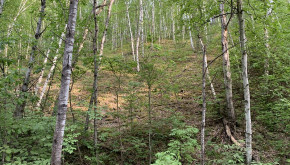
“Keep your woods healthy.” That’s a statement that many of us in Extension often tell landowners. Unfortunately, maintaining a healthy woodland is getting more difficult because of the large number of challenges they face.
Woodlands face threats from insects like the emerald ash borer and other pests and diseases. Drought can make trees more susceptible to these forest health problems. A changing climate, combined with these challenges, can lead to unhealthy woods in the future.
Here are four principles to keep in mind as you consider how to manage the uncertainty of your woods in the future.
1. Keep Woodlands as Woodlands
Woodlands provide many benefits, such as clean water, wildlife habitat, carbon sequestration, and wood products. But woodlands can only provide these goods and services if they remain as woodlands.
To continue your legacy and protect your woods from development and other land-use changes, consider the future of your land. Contact a forester or Extension professional in your state to inquire about conservation easements on your property. The University of Minnesota Extension has information on woodland transition planning that can help you work with your heirs. Your long-term planning will be fruitful only if the woodland is there for the long-term.
2. Maintain Woodland Health and Vigor
Maintaining a healthy, vigorous woodland is one of the best protections against risks. Actively managing your woodland to promote growth, species diversity, and a complex stand structure reduces vulnerability to pests.
The changing climate is expected to create more stress. For example, more frequent drought stress is expected across many regions, and this can create attractive conditions for some invasive species, forest pests, and pathogens. A woodland with a diverse mix of species may be able to withstand climate change and the accompanying stressors.
3. Address Vulnerabilities
Your woods may be vulnerable to climate change if there is a risk of declining health, productivity, or forest cover. It also may be at risk if there may be a substantial shift from one forest type converting to another. Some risk factors, such as lower than expected species diversity, may not be a sign of an immediate crisis but rather that past practices have encouraged a particular species or age class.
A number of tools can help you identify potential risks for your property which can be addressed over time. For example, the Northern Institute of Applied Climate Science has worked with many states to develop woods health scorecards and actions for landowners. These scorecards ask landowners to assess risk and to learn how to adapt their properties to climate change.
4. Woodland Management Can Help
Woodland management is the purposeful intervention by humans, using ecological principles, to optimize woodland health, along with desired goods and services. If your woods are vulnerable to climate change or if they are challenged by current disturbances, management can help ensure that you have the best possible change for a successful outcome. Contact your local state natural resources agency or Extension professional to ask how to get in touch with a forester that can help you set your woodland management goals
By guest author, Matt Russell, University of Minnesota
Photo by E. Sagor, University of Minnesota
- Portions of this post adapted from Keep your woods healthy for tomorrow: a tool to assess risk in Minnesota's changing climate

